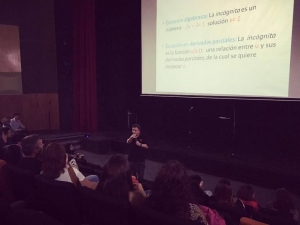mathematician and National Exact Sciences Award 2013, Manuel del Pino Manresa, spoke of his beginnings in the Instituto Nacional and exposed the community his way of understanding mathematics.The 
On Saturday, March 25, at the Casa de la Cultura Violeta Parra, located in the same commune, young people, proxies and members of the commune of Cerro Navia met to receive the academic year 2017 of the new Preuniversitario Solidario Pedro Aguirre Cerda.
On the occasion, the Ballet Folklorico de Cerro Navia “BAFOCENA” and the academician of the Pontificia Universidad Católica de Valparaíso, Jorge Rojas Vallejos, promoter of the free pre-university course were also presented “It is the first time that an initiative of this type is carried out in the commune, The people are super happy and the professional level is very good. With this we want to demonstrate that volunteer work can also be quality work, “said Rojas.
Also, the researcher of the Center for the Analysis of Partial Differential Equations (CAPDE), Manuel del Pino, also highlighted the level of those behind the initiative and commented that “Some of them have experience with popular preuniversities where the dropout rate of These initiatives are high and take on as a challenge to retain these young people and effectively help them to perform well in the PSU (Test for Universitary Selection). It is comforting to see a group of academically and intellectually gifted people with sensitivity and commitment to our society. “
Along with this, and in relation to his past as an “institutano”, the National Prize of Exact Sciences highlighted in his talk the commitment of public education with the nation and the motto of this school since the beginning of the republic, “Work wins it all”. Alluding and urging young people to work hard to achieve great achievements.
Along with this, Manuel del Pino, in his talk on equations in partial derivatives, referred to the beauty of mathematics, explaining through different equations, how these codes can model phenomena of a very diverse nature such as climate, through examples as the heat equation.
“In my talk I tried to show them that mathematics is not just to get accounts with numbers. In the equations themselves there is a certain divinity. The complexity of the phenomena behind a specific equation is infinite, and understand them a fascinating challenge,” said the mathematician, who explained his conception of this discipline, “mathematics is in itself beauty and harmony, which tries to reflect the beauty and harmony that exist In the universe”.